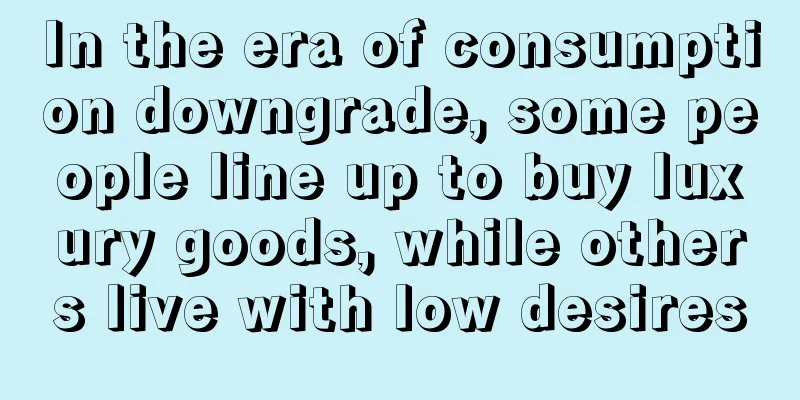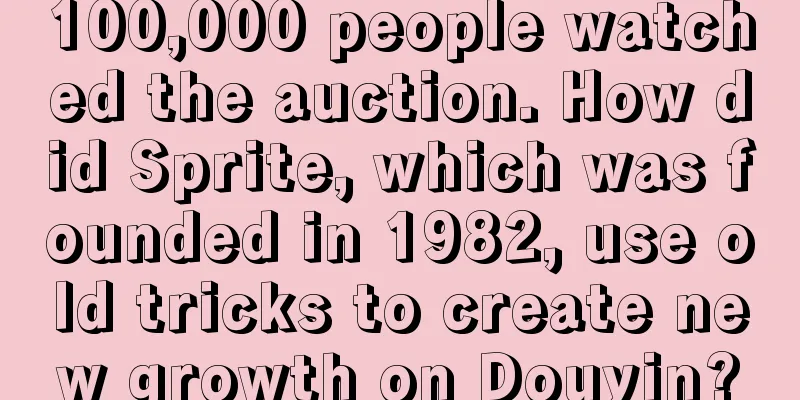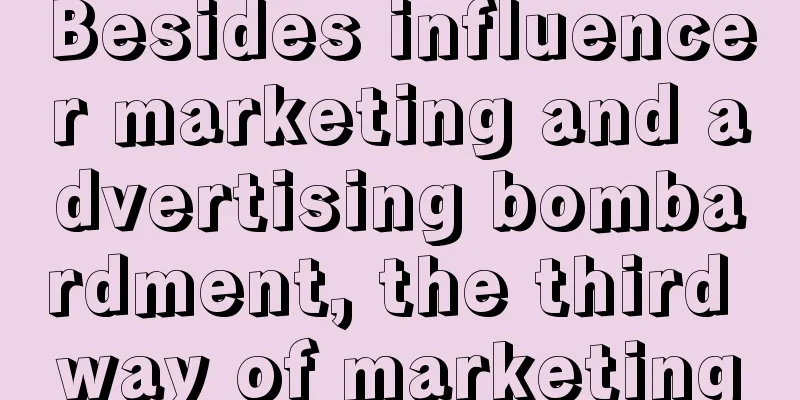In the era of consumption downgrade, some people line up to buy luxury goods, while others live with low desires

Recently, there were reports that LV will make its first global price adjustment this year on February 18, with the price adjustment ranging from 8% to 20%. Influenced by this news, many LV stores had long queues. Many people lament that the economic situation is not good. On one hand, rich people are lining up to buy luxury goods, while on the other hand, a bunch of young people cannot find jobs and have no income, and begin to pursue low-desire consumption. Luxury and low desire have always been the two levels of consumption, and have become a manifestation of consumption stratification. So should a society encourage heavy consumption or thrift? Frugality is the simplest attitude towards life. It tells us that if we want to get rich and keep our wealth, we must be frugal and not waste or be extravagant. Before and after the birth of classical economics, consumption was seen as a behavior that was beneficial to society and the country, and people had the right to enjoy comfort, pleasure and luxury. Today, luxury consumption is no longer considered a big problem, nor is it considered immoral. The more consumers like to consume, the more dynamic the economy and the more vibrant the country will be. Both Keynesians and liberals recognize the great value of consumption. However, criticisms of consumption continue, the most typical of which is that shopping, advertising, brands and loose credit have over-stimulated consumption, and consumers have been led to buy goods they do not need. This trend is called "consumerism", which is believed to be caused by waste due to excessive consumption, and excessive comparative and ostentatious consumption leading to self-loss and alienation. Frugality and overconsumption are like a pair of twins. They have been alternating in human history and have shaped the consumption concepts of contemporary people. 01 Diligence and thrift make the country richerDiligence and thrift have always been virtues advocated by the government and society. In The Republic, Plato explores the downfall of a noble and frugal city-state that was "corrupted by a life of extravagance and luxury." When citizens maintained their basic natural needs, the city-state was in a 'healthy state.' However, once people began to pursue material pleasures, they would constantly demand more, a phenomenon that ultimately led to war and corruption. As extravagant living weakens the manly citizens, domestic decay exacerbates foreign aggression. Loss of self-control transforms vigorous citizens into languid, brute men who are powerless to defend themselves. The corruption of the flesh inevitably leads to the corruption of the republic. It can be seen that diligence and thrift are regarded as virtues by Plato and are the foundation of a prosperous country. In medieval Europe, in order to curb excessive luxury, an anti-luxury decree was passed, which was the most direct manifestation of prohibiting luxury and advocating thrift. "One of them enforces that wedding gifts cannot exceed six forks and six spoons, while another details the types of desserts that can be served at banquets (only seasonal fruits and small pastries)." The Venetian theory was that greed was the root of all evil and extravagant spending was a threat to the country. It was common sense during the Renaissance that luxury could easily lead to debauchery, and appropriate luxury could only be enjoyed by the church, where magnificent buildings and paintings could reasonably be claimed to be for the purpose of increasing the glory of God. For philosopher Jean-Jacques Rousseau, the desire for things turned free men into slaves. Fashionable clothes and excessive pleasures led people away from their true selves. Rousseau himself therefore wore a simple Armenian coat. He extended this view to political advocacy, arguing that a republic required an egalitarian system and that luxury destroyed equality and reduced people to objects. In the early 20th century, Max Weber published "The Protestant Ethic and the Spirit of Capitalism". He believed that the Puritan ethics of diligence, thrift, opposition to extravagance and the goal of glorifying God were the driving force behind the formation of capital. Therefore, diligence and thrift were considered by Max Weber to be necessary conditions for the development of capitalism. Since ancient Greece, the simplest view has been that diligence and thrift are noble virtues that can make a country rich and powerful. 02 Consumption can make a country richThe view that consumption can promote the economy and that excessive consumption will not harm the economy is a cognition that emerged after the gradual formation of modern commercial society. Starting in the late 17th century, some economic writers began to argue that consumption benefits countries by expanding markets for producers and investors and also makes them richer. In 1714, in The Fable of the Bees, the Dutch physician and philosopher Bernard Mandeville noted: “A man is often judged by his clothes and other attire. By the number of his trappings we may judge his wealth; by the manner in which he dresses, his understanding.” "It is for this reason" that a person "chooses to wear clothes that are above his class... and therefore he is naturally happy to be respected by the majority, not because of who he really is, but because of who he appears to be." Mandeville's work actually reveals the idea that individual material desires will increase everyone's gains, making the entire nation richer and more powerful. In 1776, Adam Smith's "The Wealth of Nations" was published. This book first proposed the operating laws of modern commercial society. He believed that everyone's pursuit of economic self-interest promoted the operation of the entire social economy. He said that "consumption is the only purpose of all production activities." By the 1860s and 1870s, WS Jevons, Carl Menger and Leon Walras were arguing that it was consumption, not labour, that created value. The development of cotton was an early manifestation of Adam Smith's theory. Initially, Europeans' clothing was made of cheap and monotonous linen, as a material manifestation of a new culture of comfort. Compared with linen and wool products, cotton is lighter and feels smoother on the skin. At first, cotton cloth was circulated among the nobility and above, and later began to spread to middle-class consumer groups such as workers and the general public. The development of cotton cloth and its popularity among the masses promoted the circulation of this commodity and the prosperity of the cotton cloth economy, and cotton cloth became the first global mass consumer product. With the development of commercial society, furniture, wallpaper, porcelain and other belongings in the home began to show a person's elegant taste. "In 1713, 197,000 yards of wallpaper were sold in Britain. Seventy years later, that number was over 2 million. By that time, it was common to change the wallpaper in your home every few years." In the late 19th century, the prosperity of department stores became a symbol of the new society. People in the late 19th century did see the department store as a symbol of the new society. In 1906, Le Bon Marché covered 53,000 square meters, with glass panels creating an almost continuous shop window from the sidewalk to the roof. Marshall Field's introduced electric lighting in 1882. The Muir & Mililis department store building was the first building in Moscow to have an elevator (1908). At the Corwin department store in Budapest, the elevators attracted so many people that the department store decided to charge passengers a fee. The emergence of department stores symbolizes the extreme prosperity of the commodity economy, where a dazzling array of goods is overwhelming. Even the general public who do not consume much can go to department stores to experience the prosperity of the commercial society. 03 Does consumerism boost the economy?After Adam Smith, more and more economists began to defend consumption, and it became almost a recognized theory that consumption promotes national prosperity. Keynes was the economist who most famously championed consumption. In 1931, he published a work that attempted to turn the moral of consumption on its head. Saving money was a sin in a recession, he wrote: “For every five shillings you save, you keep a man out of work for a day.” He urged “patriotic housewives” to “enjoy shopping” instead and indulge themselves. The government also needed to spend, not cut. Keynes's "General Theory of Employment, Interest and Money" was published in 1936. He believed that the state should create demand and stimulate investment and consumption. The development of the Industrial Revolution and the establishment of capitalism symbolize that consumption has become a recognized correct behavior. The Industrial Revolution improved production efficiency and reduced the prices of goods, thus achieving economic democracy - everyone can buy what they want. Even if you cannot afford to buy goods in the short term, credit will give you more choices. For example, Ford Motor Company, on the one hand, lowered the price of cars, and on the other hand, provided credit tools to the middle class, allowing them to pay in installments and own goods in advance. Since then, General Motors has developed credit to the extreme. Some people believe that credit leads to irrational consumer consumption, but Columbia University economist ER Seligman disagrees. In a 1927 article, he believed that credit can arouse people's desire for a better life. “The richer, higher, and more refined his tastes…the greater his intelligence, his efficiency, his true capacity for cooperation.” The whole nation would benefit. 04 How do advertising and marketing encourage consumption?Once consumption became an unquestionable moral behavior, businessmen began to think of ways to encourage consumption in order to build their own business empires, and the development of advertising and marketing played an indispensable role in this. If advertisements are presented only through text, without pictures or videos, perhaps their effect in promoting consumption will be limited. Indeed, until the end of the 19th century, text-based advertising was little more than a description of a product’s physical properties, its price, and its uses. Text ads were mostly limited to the font and layout, and often felt monotonous and boring. When consumers see this kind of advertisement, their general mentality is that they think it is a necessity and they will learn about it if they really need it. Otherwise, they will not even take a second look at it. The revolution in advertising comes from the tremendous changes brought about by pictures and videos. This kind of advertising not only describes the physical properties of products, but more importantly, it mobilizes consumers' vision and creates associations through artistic techniques such as exaggeration and metaphor. It not only allows the physical functions of the goods to be more fully displayed, but also connects the goods with the psychological needs of consumers, stimulating consumers' needs from both material and spiritual aspects. Under the suggestion of the advertisement, the audience projects themselves into the dream life expressed in the advertisement, which is sometimes as idyllic as a poem. At the same time, the emergence of consumer culture has enabled more and more people to put their dream lives into practice, with magazines and movies being two powerful driving forces. “Magazines made shopping natural and commonplace, giving people easy glimpses into new things and new lives that were once unimaginable and expensive. At the same time, magazines also instill new vocabulary, new standards, and new anxieties. For example, in the early 20th century, magazine articles and advertisements began to use a lot of advanced biological and pharmacological terms such as sterilization, disinfection, microorganisms, or epidermis, with the purpose of promoting people's demand for toiletries and cosmetics. " The magazine is not a reflection of reality, but a reflection of dreams. It makes people dream of a wealthy life, and the people in the illustrations are like readers experiencing luxury. At the same time, it makes the bourgeois luxury, wonderful values and lifestyle "popular". The life constructed by the magazine is perfect. Roland Marchand quipped: "If historians study American history based on this alone, they may think that all Americans at that time were rich and outstanding." Movies are the embodiment of a perfect life. The characters that often appear in movies are beautiful and elegant ladies and free-spirited gentlemen. The audience mistakenly thinks they are the characters in the movies and strive to achieve the life conditions in real life. In the 1940s, a study showed that 61% of Hollywood movie protagonists were wealthy or even very wealthy, while in reality, only 0.05% of the population in the country were such people. 05 Reflection on ConsumerismThe road to encouraging consumption is not endless, and the problems brought about by consumerism have also been reflected upon. In his 1979 book Distinction, Bourdieu argued that each class has its own unique system of taste: “Taste brings people and things together.” Simply put, Bourdieu believes that consumer goods bring about class distinctions. At the same time, many people spend money on goods that do not belong to their own class in order to show off. In 1899, Thorstein Veblen, an unorthodox Chicago economist, proposed the concept of "conspicuous consumption" in "The Theory of the Leisure Class". He believed that consumption was to keep up with the consumption level of friends and neighbors around, and to make their friends and neighbors jealous. At the same time, he proposed the Veblen effect - the more expensive a product is, the more consumers want to buy it, and the cheaper it is, the less they want to buy it. Because the more expensive the product, the more it can show one's dignity and taste, and the more it can make friends and neighbors jealous. Paul Fussell published the book Style in the 1980s, which explored the consumption and living habits of different classes. This is a popular interpretation of Bourdieu and Veblen’s theories. In the book, he pointed out the perception of consumption among people of different classes. "People at the bottom like to believe that class is determined by how much wealth a person has; people in the middle admit that money is related to class differences, but a person's education and the type of work they do are equally important; people near the top believe that taste, values, lifestyle and behavior are indispensable criteria for judging class status, and do not consider money, occupation or education." Paul Fussell's theory is close to what we call the distinction between the lower class, the middle class, the cultural elite, etc. today. When they write about the differences between different classes, they are more reflecting on the irrational consumption brought about by consumerism and the emotions of consumers who are lost in the commodity society and cannot find what they really want. 06 Desire and consumption always move forwardAt the end of the 20th century, supermarkets, advertising and credit developed into milestones on the path to the neoliberal “trinity” of choice, individualism and markets. They are important elements in shaping contemporary consumer society and they create the prosperity of contemporary commercial society. Although consumerism promotes the economy, it does not solve the wasteful behavior caused in the economic society. According to a Roy Morgan Research Institute survey, almost 20% of Australian women buy a new pair of shoes every four weeks, which is equivalent to adding millions of new pairs of shoes to Australian wardrobes every year. These shoes will eventually end up in landfills along with the approximately 300 million pairs of discarded shoes around the world each year, taking an average of 50 years to degrade. Therefore, a question worth pondering is, if we use the money saved from overconsumption to innovate, will we create more valuable products? 【References】 New Philosopher: To Buy or Not to Buy Empire of Commodities Manufacturing Consumers Author: Xunkong WeChat public account: Xunkong’s Marketing Revelation (ID: xunkong2005) |
<<: Xiaohongshu's "virtual bloggers" are in a "surge" phase
>>: Building a UGC content ecosystem from 0 to 1
Recommend
List of 182 popular titles on Xiaohongshu.
Want to create popular content on Xiaohongshu? The...
How to send SMS messages for cross-border e-commerce marketing? How to promote?
In today's digital age, the cross-border e-com...
With sales of 5 million overnight and an increase of over 4 million followers, it took on the heat of the "business war", but is the challenge just beginning?
As the incident of a head anchor fermented, the he...
Another 618, no winners
Why is there no winner in this year's 618? Thi...
When it comes to understanding young people’s emotions, can brands not compare to temples?
Recently, temples have gradually become a popular ...
Al adds to the hype, triggering the "lying flat" tourism
This article explores how AI technology can bring ...
A "super rich second generation" has arrived in the competitive 9.9 coffee market
Ken Yue Coffee joins the 9.9 yuan coffee price war...
How to write Amazon SKU? What are the writing rules?
Now there are more and more merchants opening stor...
Go first and plan later, "advisory travel" has changed independent travel
Explore the novel model of "advisory travel&q...
Is it necessary to pay to register a Google account? How to register a Google email account?
In our country, more and more users are starting t...
Will Amazon's advertising suspension affect ranking? How to restore the effect?
One of the means of operating an Amazon store is t...
Is it better to send goods on behalf of others or send them on your own? How to operate?
Shopee is an e-commerce platform in Southeast Asia...
What are the risks of cross-border e-commerce? Can you make money?
With the development of globalization, cross-borde...
What do the hot-selling products on Pinduoduo look like?
In the fiercely competitive e-commerce market, how...
Northeast Rain Sister has fallen into trouble again. How many people can this "crab" drag into the water?
TikTok influencer “Northeast Rain Sister” has spar...









